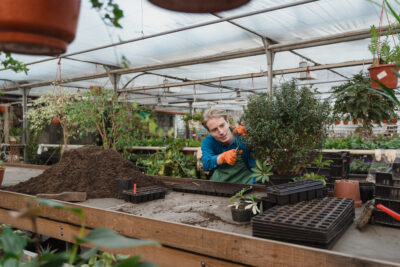
Are Succulents Affected by Overwatering?

Succulents have become increasingly popular in recent years as houseplants and garden additions. Known for their ability to store water in their leaves, stems, and roots, these plants have gained a reputation for being resilient and low-maintenance. However, despite their reputation for being drought-tolerant, succulents can still be negatively affected by overwatering.
We will explore the potential consequences of overwatering succulents and how to prevent them. We will discuss the signs of overwatering, such as yellowing leaves, root rot, and wilting, and explain why succulents are susceptible to these problems. Additionally, we will provide tips on how to properly water succulents, including the frequency and amount of water they need. By understanding the risks of overwatering and implementing proper watering techniques, succulent enthusiasts can ensure the health and longevity of their plants.
- Yes, succulents can be affected by overwatering
- Overwatering can lead to root rot in succulents
- To prevent overwatering, make sure the soil is completely dry before watering again
- Succulents have adapted to survive in dry conditions, so they prefer well-draining soil
- It is important to water succulents sparingly to avoid overwatering
- Signs of overwatering in succulents include yellowing leaves, mushy stems, and a wilted appearance
- If you suspect your succulent is overwatered, allow the soil to dry out completely before watering again
- Proper watering practices are essential for the health and survival of succulents
- Frequently Asked Questions
Yes, succulents can be affected by overwatering
Overwatering is one of the most common mistakes that succulent owners make. While succulents are known for their ability to store water in their leaves and stems, they are not immune to the negative effects of excess moisture. In fact, overwatering can lead to a number of problems for these plants.
Root Rot
One of the main issues that arise from overwatering succulents is root rot. When succulents are watered too frequently or their soil does not have sufficient drainage, the roots can become waterlogged. This excess moisture creates a perfect breeding ground for fungi and bacteria, which can cause the roots to rot. Root rot is a serious condition that can lead to the death of a succulent if left untreated.
Yellowing and Wilting
Another visible sign of overwatering in succulents is yellowing and wilting of the leaves. When succulents receive more water than they need, their leaves become swollen and start to lose their firmness. This can lead to the leaves turning yellow or even transparent. Additionally, overwatered succulents may appear wilted, as the excess water disrupts the balance of nutrients and oxygen uptake.
Pest Infestation
Overwatering can also attract pests to succulents. The constant presence of moisture can create a favorable environment for insects like fungus gnats, mealybugs, and aphids. These pests can cause further damage to the already weakened succulent, feeding on the plant's tissues and leaving it vulnerable to diseases.
 Using Sphagnum Moss as a Growing Medium for Succulents: Pros and Cons
Using Sphagnum Moss as a Growing Medium for Succulents: Pros and ConsPreventive Measures
To avoid the negative effects of overwatering, it is essential to understand the watering needs of succulents. Here are a few preventive measures to keep your succulents healthy:
- Use well-draining soil specifically formulated for succulents
- Water only when the soil is completely dry, typically every 1-2 weeks depending on environmental conditions
- Ensure that the pot has drainage holes to allow excess water to escape
- Avoid misting or spraying water directly on the leaves
- Adjust watering frequency based on the season and temperature changes
By following these guidelines, you can provide your succulents with the optimal watering conditions, ensuring their health and longevity.
In conclusion,
overwatering can have detrimental effects on succulents. It is important to strike a balance between providing enough water for these plants to thrive and avoiding excessive moisture that can lead to root rot, yellowing and wilting of leaves, and pest infestation. With proper care and understanding of their watering needs, you can enjoy a thriving succulent collection.
Overwatering can lead to root rot in succulents
One of the most common mistakes made by succulent owners is overwatering. While succulents are known for their ability to store water in their leaves and stems, they are not immune to the negative effects of excess moisture. Overwatering can lead to root rot, a condition where the roots of the plant become waterlogged and start to decay.
Signs of overwatering in succulents
 Optimal Soil for Succulents: Understanding Preferred Types
Optimal Soil for Succulents: Understanding Preferred TypesIt's important to be able to recognize the signs of overwatering in your succulents so that you can take action to correct the issue. Some common signs include:
- Yellowing or wilting leaves
- Soft and mushy stems
- Blackened or rotting roots
- Foul odor coming from the soil
Preventing overwatering
To prevent overwatering and root rot in your succulents, it's important to follow these guidelines:
- Choose well-draining soil: Succulents thrive in soil that allows excess water to flow out easily. You can use a special succulent or cactus mix, or create your own by adding coarse sand or perlite to regular potting soil.
- Water sparingly: Succulents have low water needs and prefer to dry out between waterings. Allow the soil to completely dry before watering again. As a general rule, water your succulents once every 1-2 weeks, depending on the climate and humidity.
- Avoid water accumulation: Make sure your succulents are planted in pots with drainage holes to allow excess water to escape. Avoid using saucers or trays that can trap water and lead to overwatering.
- Observe and adjust: Pay attention to your succulents' appearance and adjust your watering routine accordingly. If you notice signs of overwatering, reduce the frequency of watering.
Conclusion
While succulents are generally hardy plants that can withstand periods of drought, overwatering can be detrimental to their health. By being mindful of their water needs and taking steps to prevent overwatering, you can ensure that your succulents thrive and avoid the risk of root rot.
To prevent overwatering, make sure the soil is completely dry before watering again
One of the most common mistakes when caring for succulents is overwatering. While these plants are known for their ability to store water in their leaves, they can still suffer from the negative effects of excessive moisture.
When succulents are overwatered, their roots become saturated, which can lead to root rot. This condition occurs when the roots are deprived of oxygen, causing them to decay. As a result, the plant's ability to absorb water and nutrients is compromised, ultimately leading to wilting, yellowing, and even death.
 Can Succulents Be Submerged in Water for Extended Periods?
Can Succulents Be Submerged in Water for Extended Periods?To prevent overwatering, it is crucial to ensure that the soil is completely dry before watering again. This means that you should allow the top inch or two of the soil to dry out completely between waterings. Succulents thrive in well-draining soil, so it is essential to choose a potting mix specifically designed for these plants.
Additionally, it is important to water succulents deeply but infrequently. When you do water, make sure to thoroughly saturate the soil, allowing the excess water to drain out of the bottom of the pot. This will help flush out any built-up salts or minerals that can accumulate in the soil over time.
Signs of overwatering
It is crucial to be able to recognize the signs of overwatering in succulents. Some common indicators include:
- Soft, mushy leaves
- Yellowing or browning leaves
- Wilting or drooping
- Root rot
- Mold or fungal growth
If you notice any of these symptoms, it is important to take immediate action to save your succulent. Start by removing the affected leaves and allowing the soil to dry out completely. Adjust your watering schedule accordingly and ensure that the plant is receiving adequate sunlight and airflow.
Preventing overwatering
Apart from proper watering practices, there are a few other tips to prevent overwatering your succulents:
 Can Succulents Thrive in Potting Soil or Do They Require Special Care?
Can Succulents Thrive in Potting Soil or Do They Require Special Care?- Use pots with drainage holes to allow excess water to escape.
- Avoid using saucers or trays underneath the pots, as they can trap water and lead to root rot.
- Provide adequate sunlight to promote healthy growth and drying of the soil.
- Ensure proper airflow around the plants to prevent moisture buildup.
- Monitor the weather conditions and adjust your watering schedule accordingly. Succulents may need less water during cooler months or periods of high humidity.
By following these guidelines and being attentive to your succulents' needs, you can prevent overwatering and ensure their long-term health and vitality.
Succulents have adapted to survive in dry conditions, so they prefer well-draining soil
Succulents, with their unique ability to store water in their leaves and stems, have evolved to thrive in arid environments. These plants are known for their ability to survive in dry conditions, making them a popular choice for indoor and outdoor gardens. One important factor to consider when caring for succulents is their preference for well-draining soil.
Unlike other plants, succulents are extremely susceptible to overwatering. Their roots are designed to absorb water quickly and efficiently, but they can easily become waterlogged if left in damp conditions for too long. When this happens, the roots can rot, leading to root rot and ultimately the death of the plant.
The signs of overwatering in succulents
It's important to be able to recognize the signs of overwatering in succulents to prevent any potential damage. Some common indicators include:
- Yellowing leaves: If the leaves of your succulent are turning yellow and becoming mushy, it's a clear sign of overwatering. The excess moisture causes the leaves to swell and eventually rot.
- Soft and squishy stems: When the stems of a succulent become soft and mushy to the touch, it indicates that the plant is receiving too much water. The excess moisture weakens the stems and makes them prone to breakage.
- Blackened or brown roots: If you notice a foul smell or see blackened or brown roots when repotting your succulent, it's likely that the roots have been affected by overwatering. Healthy roots should be firm and white.
Preventing overwatering in succulents
To prevent overwatering, it's crucial to provide succulents with well-draining soil. This type of soil allows excess water to escape quickly, preventing waterlogged conditions. You can create a well-draining soil mix by combining regular potting soil with perlite or coarse sand.
Furthermore, it's important to establish a watering routine that suits your specific succulent's needs. As a general rule, it's better to underwater than to overwater succulents. Allow the soil to dry out completely between waterings and only water when the top inch of soil feels dry to the touch.
By understanding the preferences and needs of succulents, you can ensure their health and longevity. Remember, when it comes to watering succulents, less is often more!
 Find the Best Soil for Your Succulents with Eb Stone
Find the Best Soil for Your Succulents with Eb StoneIt is important to water succulents sparingly to avoid overwatering
Overwatering can be detrimental to succulents, as they are adapted to thrive in dry conditions. Succulents have evolved to store water in their leaves, stems, or roots, enabling them to survive in harsh environments with limited water resources. Therefore, it is crucial to provide these plants with the right amount of water to prevent overwatering.
When succulents receive excess water, their roots can become waterlogged, leading to root rot. This condition occurs when the roots are unable to access oxygen, causing them to decay. As a result, the plant's ability to absorb water and nutrients is compromised, leading to wilting, yellowing, or even death.
Signs of Overwatering Succulents
To determine if your succulent is being overwatered, there are several signs to look out for:
- Yellowing or translucent leaves: Overwatered succulents may develop yellow or see-through leaves, indicating that they are holding too much moisture.
- Soft and mushy leaves: If the leaves of your succulent feel soft and mushy to the touch, it is a sign of overwatering. Healthy succulent leaves should be firm and plump.
- Root rot: If you notice a foul smell or mushy roots when repotting your succulent, it is a clear indication of overwatering and root rot.
- Wilting: While wilting can be a sign of both overwatering and underwatering, if the soil is consistently damp and the plant appears limp, overwatering is likely the cause.
If you observe any of these signs, it is crucial to take immediate action to save your succulent from further damage.
Preventing Overwatering
To prevent overwatering your succulents, follow these tips:
- Use well-draining soil: Plant your succulents in a well-draining soil mix specifically formulated for succulents and cacti. This type of soil allows excess water to flow away from the roots, preventing waterlogging.
- Water sparingly: Succulents have low water requirements. Water them only when the soil is completely dry, typically every 1-2 weeks, depending on the climate and season.
- Water from the bottom: Instead of watering from the top, which can lead to water sitting on the leaves and causing rot, place your succulent pot in a shallow tray filled with water. The plant will absorb the water it needs through the drainage holes in the bottom of the pot.
- Provide adequate sunlight: Succulents thrive in bright light conditions. Ensure that your succulents receive at least 6 hours of direct sunlight each day to support their optimal growth and water absorption.
By following these guidelines, you can ensure that your succulents stay healthy and vibrant, free from the negative effects of overwatering.
 The Soak and Dry Method for Succulents: A Comprehensive Guide
The Soak and Dry Method for Succulents: A Comprehensive GuideSigns of overwatering in succulents include yellowing leaves, mushy stems, and a wilted appearance
Succulents are known for their ability to thrive in arid conditions and store water in their leaves and stems. However, despite their resilience, overwatering can still have detrimental effects on these hardy plants. It is important to understand the signs of overwatering in succulents to prevent damage and promote their overall health.
One of the most common signs of overwatering in succulents is the appearance of yellowing leaves. When succulents receive more water than they need, their leaves become waterlogged and start to lose their vibrant color. This yellowing is a clear indication that the plant is being overwatered.
In addition to yellowing leaves, overwatered succulents may also exhibit mushy stems. When the plant receives excessive moisture, the stems become soft and squishy to the touch. This is a result of the cells in the stems becoming filled with water, causing them to lose their rigidity. Mushy stems can lead to structural instability and an increased risk of rot.
Another telltale sign of overwatering in succulents is a wilted appearance. Surprisingly, overwatered succulents can actually look like they are lacking water. This is because overwatering inhibits the plant's ability to take in oxygen, leading to root rot and a general decline in health. As a result, the leaves may become limp and droopy, mimicking the appearance of underwatered plants.
To ensure the health of your succulents, it is crucial to strike a balance between watering and allowing the soil to dry out. The frequency of watering will depend on various factors such as the type of succulent, the climate, and the potting mix used. As a general rule of thumb, it is best to water succulents thoroughly but infrequently, allowing the soil to dry out completely between waterings.
Remember, overwatering can be just as harmful as underwatering when it comes to succulents. By being mindful of the signs of overwatering and adjusting your watering routine accordingly, you can help your succulents thrive and enjoy their unique beauty for years to come.
If you suspect your succulent is overwatered, allow the soil to dry out completely before watering again
Overwatering is a common mistake made by succulent owners. While these plants are known for their ability to store water in their leaves and stems, they are not immune to the negative effects of excessive moisture. If you suspect that your succulent is overwatered, it is important to take immediate action to prevent further damage.
 Where to Find Succulent Soil at Home Depot: Your Guide to Buying
Where to Find Succulent Soil at Home Depot: Your Guide to BuyingOne way to determine if your succulent is overwatered is by checking the soil moisture level. Stick your finger about an inch into the soil - if it feels wet or soggy, then it is likely that you have been overwatering. In this case, it is crucial to allow the soil to dry out completely before watering again.
By giving the soil time to dry out, you are allowing the excess moisture to evaporate and preventing the roots from suffocating. This is especially important as succulent roots are adapted to dry conditions and can rot if constantly exposed to water.
In addition to allowing the soil to dry, it is also important to adjust your watering schedule. Succulents typically thrive in well-draining soil and prefer to be watered infrequently but deeply. So, instead of giving your succulent small amounts of water frequently, water it thoroughly but less often. This will mimic the natural rainfall patterns these plants are accustomed to in their native habitats.
Another way to combat overwatering is to ensure that your succulent is planted in a suitable container with proper drainage. Choose a pot with drainage holes at the bottom to allow excess water to escape. This will prevent water from pooling at the bottom of the pot and creating an environment that promotes root rot.
Furthermore, be cautious of the potting mix you use for your succulent. Opt for a well-draining soil mix specifically formulated for succulents. These mixes often contain ingredients like perlite or sand, which help to improve drainage and prevent waterlogged roots.
While succulents are known for their ability to withstand drought, they are not invincible to the effects of overwatering. To ensure the health and longevity of your succulents, it is important to be mindful of your watering practices. Remember to allow the soil to dry out completely, adjust your watering schedule, use containers with proper drainage, and choose a well-draining potting mix. By doing so, you can avoid the detrimental consequences of overwatering and enjoy a thriving succulent collection.
Proper watering practices are essential for the health and survival of succulents
When it comes to caring for succulents, one of the most common questions that arise is whether these plants are affected by overwatering. Succulents, known for their ability to store water in their leaves and stems, have adapted to survive in arid environments where water is scarce. As a result, overwatering can have detrimental effects on these plants.
 Proper Watering Frequency for Repotted Succulents: A Guide
Proper Watering Frequency for Repotted Succulents: A GuideOverwatering succulents can lead to a variety of problems, including root rot, leaf drop, and even death. The excess moisture in the soil can cause the roots to become waterlogged, preventing them from absorbing oxygen. This lack of oxygen can lead to root rot, which is a fungal infection that can quickly spread throughout the plant.
Additionally, overwatering can cause the leaves of succulents to become soft and mushy. This is a sign that the plant is suffering from edema, a condition caused by the uptake of excess water. The excess water accumulates in the cells of the leaves, causing them to swell and eventually burst. This can result in irreversible damage to the plant.
Signs of Overwatering in Succulents
It is crucial to be able to recognize the signs of overwatering in succulents to prevent any further damage. Here are some common signs to look out for:
- Yellowing or wilting leaves: Overwatered succulents may develop yellow leaves that appear wilted or droopy. This is a result of the roots being unable to absorb oxygen due to waterlogged soil.
- Soft or mushy leaves: Succulent leaves should feel firm and plump. If the leaves become soft or mushy to the touch, it is a clear indication of overwatering.
- Root rot: If you notice a foul odor coming from the soil or black, mushy roots when you remove the plant from its pot, it is likely suffering from root rot caused by overwatering.
- Pest infestation: Overwatered succulents are more susceptible to pests such as fungus gnats, which thrive in moist environments.
To ensure the health and well-being of your succulents, it is vital to develop proper watering habits. Succulents typically prefer to be underwatered rather than overwatered. They are adapted to survive in dry conditions and can store water in their leaves and stems for extended periods. As a general rule, water your succulents only when the soil is completely dry.
When watering, ensure that you thoroughly soak the soil and allow any excess water to drain out of the pot. It is also essential to choose a well-draining soil mix specifically designed for succulents. This will prevent water from sitting around the roots for extended periods, reducing the risk of root rot.
Remember, succulents are resilient plants, but they have specific needs when it comes to watering. By understanding the signs of overwatering and implementing proper watering practices, you can ensure that your succulents thrive and flourish for years to come.
Frequently Asked Questions
1. Are succulents affected by overwatering?
 Optimal Growth: Can Succulents Thrive in Potting Soil?
Optimal Growth: Can Succulents Thrive in Potting Soil?Yes, overwatering can be harmful to succulents as they are adapted to survive in dry conditions and store water in their leaves and stems. Too much water can lead to root rot and other issues.
2. How often should I water my succulents?
Succulents generally require less frequent watering compared to other plants. It is recommended to water them when the soil is completely dry, typically every 1-2 weeks depending on environmental conditions.
3. Can I save an overwatered succulent?
If your succulent has been overwatered, it is possible to save it by allowing the soil to dry out completely and adjusting your watering routine. Remove any rotted or damaged parts and ensure proper drainage in the future.
4. Should I mist my succulents?
Misting succulents is not necessary as they are adapted to dry environments. It is better to water them deeply and infrequently, allowing the soil to dry out completely between watering to promote healthy root growth.
 The Best Time to Water Your Succulent Plants: A Guide
The Best Time to Water Your Succulent Plants: A GuideIf you want to read more articles similar to Are Succulents Affected by Overwatering?, you can visit the Watering and Soil category.






You Must Read